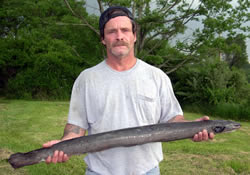|
State Record American Eel Caught
July 5, 2005
The New Jersey Department of Environmental Protection’s Division of Fish and
Wildlife has certified a new freshwater state record American eel that was caught
from Round Valley Reservoir on June 4. David J. Payne of Plainfield caught a 6
pound, 13 ounce American eel that weighed 11 ounces more than the previous record
taken from Round Valley in 1994.
|
Payne was on shore casting for trout when he hooked the eel on a live shiner.
Payne claims he saw trout all around and was convinced he had one until his catch
came closer to the surface. His “surprise” measured 41¾ inches in length.
The American eel can be found statewide in rivers, streams, ponds and reservoirs.
American eels possess a slender, muscular, snake-like body with a small pointed
head. The dorsal fin is long, extending more than half the length of the body.
They have short, rounded pectoral fins, but no pelvic fins. The mouth has numerous
small teeth. Male eels seldom exceed 24 inches in length, but females can reach
up to 40 inches.
|
 David
Payne with his record eel.
David
Payne with his record eel.
Click to enlarge |
Adult American eels migrate to the Sargasso Sea, a calm area in the Atlantic
Ocean east of the Bahamas and south of Bermuda, to spawn. The larvae reside in
the upper few hundred feet of ocean for up to a year and slowly migrate back to
the eastern shores of North America. By the time they reach the estuaries and
rivers in March and early April, they have transformed into small transparent
eels (glass eels). As the young eels develop pigmentation they become known as
elvers and will remain in fresh water until sexually mature. When ready to reproduce,
they migrate back to the Sargasso Sea late in the fall. Prior to this migration,
they sport a silvery color. Once spawning occurs, they die.
Adult eels primarily eat fish, but will feed upon anything they find. In lakes
and reservoirs, they reside in shallow coves with muddy bottoms. Eels are most
active at night and spend the winter months buried in the mud. In streams and
rivers, they can be found in pool areas with plenty of cover in the form of fallen
trees and branches, as well as undercut banks where they prefer clear water, but
will tolerate moderately cloudy conditions.
The Division has categories for American eel caught in both freshwater and
saltwater. The current saltwater state record is 9 pounds, 13 ounces caught in
1988 off Atlantic City.
The Record Fish Program recognizes the largest species of fish caught in the
state. It revolves around a specific list of eligible freshwater and saltwater
species, and is based on weight alone; there are no line classes. Scale certification
documentation, including the Certificate of Inspection/Test Report and Registration
Certificate issued by the New Jersey Office of Weights and Measures, as well as
a weighmaster’s signature are necessary. Other rules apply.
For more information or to request an application, call 609-633-7768. Visit
the Division’s Web site at www.njfishandwildlife.com/recfish.htm
for a complete list of state record fish.
Photo
|

